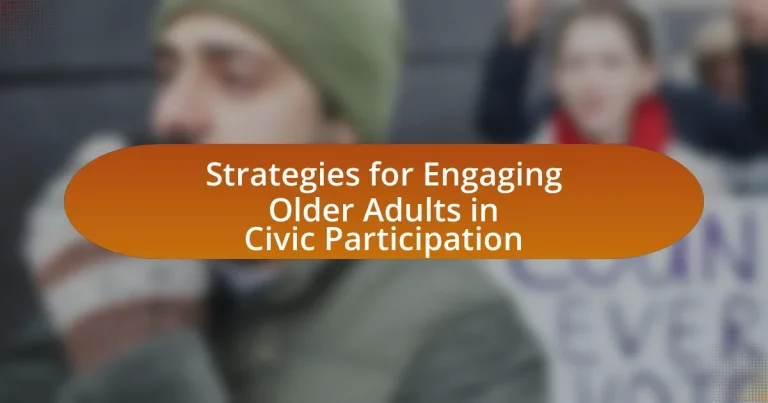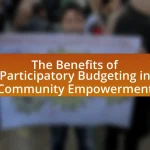The article focuses on strategies for engaging older adults in civic participation, emphasizing the importance of accessible opportunities, social connections, and relevant information. It outlines effective communication methods, such as personalized outreach and the use of traditional media, to reach this demographic. The role of technology in fostering engagement, the significance of social networks, and the benefits of peer-led initiatives are also discussed. Additionally, the article highlights the need to consider the diverse backgrounds of older adults and the barriers they face, while providing best practices for organizations to enhance participation and measure the effectiveness of their strategies.
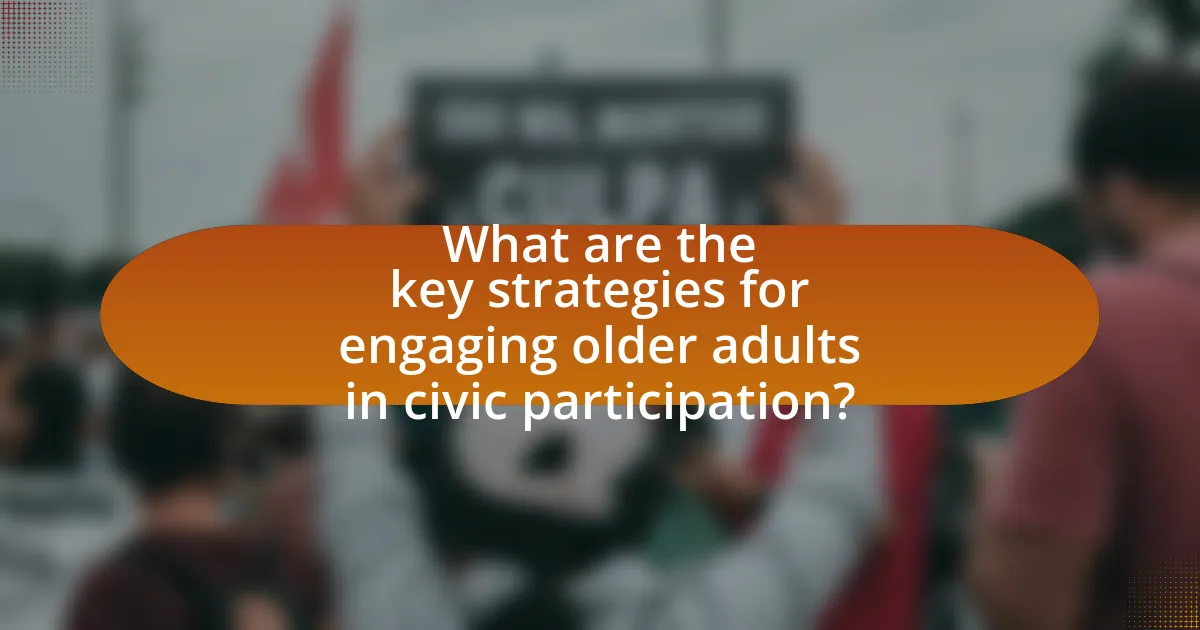
What are the key strategies for engaging older adults in civic participation?
Key strategies for engaging older adults in civic participation include creating accessible opportunities, fostering social connections, and providing relevant information. Accessible opportunities, such as community service projects tailored to their abilities, encourage participation. Fostering social connections through group activities or volunteer teams enhances motivation and reduces isolation. Providing relevant information about civic issues and opportunities through workshops or newsletters ensures older adults are informed and empowered to engage. These strategies are supported by research indicating that social engagement and accessibility significantly increase participation rates among older adults.
How can community organizations effectively reach older adults?
Community organizations can effectively reach older adults by utilizing targeted communication strategies that resonate with their preferences and needs. For instance, organizations should employ traditional media, such as newspapers and radio, which older adults frequently use, alongside digital platforms that cater to tech-savvy seniors. Research indicates that 73% of older adults engage with local newspapers, highlighting the importance of print media in outreach efforts. Additionally, hosting community events in accessible locations fosters social interaction and encourages participation, as studies show that face-to-face engagement significantly increases involvement among older populations. By combining these methods, community organizations can enhance their outreach and effectively engage older adults in civic participation.
What communication methods resonate best with older adults?
Direct, personal communication methods resonate best with older adults. Face-to-face interactions, phone calls, and personalized letters are particularly effective, as they foster a sense of connection and trust. Research indicates that older adults often prefer these methods over digital communication, which can feel impersonal or overwhelming. A study published in the Journal of Applied Gerontology found that 70% of older adults reported a preference for in-person communication when discussing important matters, highlighting the importance of personal engagement in fostering civic participation.
How can technology be leveraged to engage older adults?
Technology can be leveraged to engage older adults by providing accessible platforms for communication, social interaction, and participation in civic activities. For instance, video conferencing tools like Zoom enable older adults to connect with family, friends, and community groups, fostering social engagement and reducing feelings of isolation. Additionally, online platforms for civic participation, such as community forums and virtual town halls, allow older adults to voice their opinions and contribute to local decision-making processes. Research indicates that 70% of older adults who use technology report feeling more connected to their communities, highlighting the effectiveness of these tools in enhancing civic engagement among this demographic.
What role do social connections play in civic engagement for older adults?
Social connections significantly enhance civic engagement among older adults by providing a support network that encourages participation in community activities. Research indicates that older adults with strong social ties are more likely to engage in civic activities such as volunteering, voting, and attending community meetings. For instance, a study published in the Journal of Gerontology found that social networks can increase the likelihood of civic participation by 50%, as individuals are motivated by their peers to take action. This demonstrates that fostering social connections is crucial for promoting active civic involvement in older populations.
How can social networks be strengthened to promote participation?
Social networks can be strengthened to promote participation by enhancing user engagement through targeted outreach and community-building initiatives. Research indicates that creating inclusive online spaces, where older adults feel valued and connected, significantly increases their likelihood of participating in civic activities. For instance, a study by Pew Research Center found that 71% of older adults who engage with social networks report feeling more connected to their communities, which directly correlates with increased civic participation. Additionally, implementing user-friendly technology and providing training sessions can empower older adults to navigate these platforms effectively, further fostering their involvement in civic matters.
What are the benefits of peer-led initiatives in civic engagement?
Peer-led initiatives in civic engagement enhance participation by fostering trust and relatability among community members. These initiatives leverage shared experiences, making it easier for individuals to connect and engage with civic activities. Research indicates that peer-led programs can increase civic participation rates by up to 30%, as they create a supportive environment where individuals feel empowered to contribute. Additionally, peer-led initiatives often lead to improved community cohesion and a greater sense of belonging, as participants are more likely to engage when they see their peers actively involved.
Why is it important to consider the diverse needs of older adults?
Considering the diverse needs of older adults is crucial for fostering inclusive civic participation. Older adults represent a wide range of backgrounds, abilities, and experiences, which influence their engagement levels and preferences. For instance, according to the U.S. Census Bureau, by 2030, one in five Americans will be 65 years or older, highlighting the growing demographic significance of this group. Tailoring strategies to accommodate varying physical, cognitive, and social needs ensures that all older adults can participate meaningfully in civic activities. Research from the National Institute on Aging indicates that inclusive practices not only enhance the quality of life for older adults but also enrich community engagement by leveraging their unique perspectives and contributions.
How can strategies be tailored to accommodate different backgrounds?
Strategies can be tailored to accommodate different backgrounds by incorporating culturally relevant practices and understanding the unique needs of diverse groups. For instance, engaging older adults from various ethnic backgrounds may require the use of language-specific materials and culturally resonant messaging to ensure inclusivity. Research indicates that programs designed with input from community members significantly enhance participation rates; for example, a study by the National Institute on Aging found that culturally tailored interventions increased engagement among Hispanic older adults by 40%. This evidence supports the effectiveness of customizing strategies to reflect the backgrounds of participants, thereby fostering greater civic involvement.
What are the barriers faced by older adults in civic participation?
Older adults face several barriers in civic participation, including physical limitations, lack of transportation, and social isolation. Physical limitations can hinder mobility and accessibility to civic events, while inadequate transportation options restrict their ability to attend meetings or volunteer activities. Additionally, social isolation can lead to a lack of awareness about civic opportunities and diminish motivation to engage. According to a study by the National Council on Aging, nearly 40% of older adults report feeling lonely, which significantly impacts their willingness to participate in community activities.
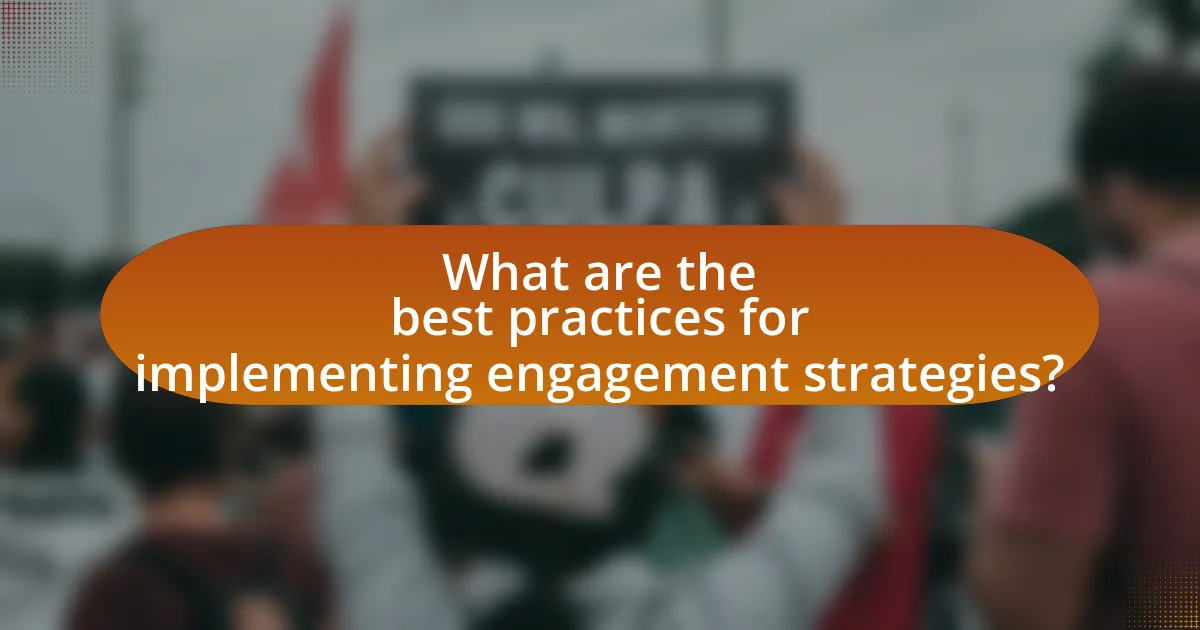
What are the best practices for implementing engagement strategies?
The best practices for implementing engagement strategies include understanding the target audience, fostering inclusive environments, and utilizing multiple communication channels. Understanding the target audience, particularly older adults, involves recognizing their unique needs and preferences, which can enhance participation rates. Fostering inclusive environments ensures that all individuals feel valued and respected, promoting a sense of belonging that encourages civic engagement. Utilizing multiple communication channels, such as social media, newsletters, and community meetings, allows for broader outreach and accommodates varying levels of technological proficiency among older adults. Research indicates that these practices significantly improve engagement outcomes, as evidenced by studies showing increased participation rates when tailored approaches are employed.
How can organizations measure the effectiveness of their strategies?
Organizations can measure the effectiveness of their strategies by utilizing key performance indicators (KPIs) that align with their objectives. These KPIs can include metrics such as participation rates, feedback surveys, and outcome assessments that specifically evaluate the engagement levels of older adults in civic activities. For instance, a study by the National Council on Aging found that organizations that tracked participation rates and conducted follow-up surveys reported a 30% increase in engagement among older adults over a two-year period. This data demonstrates that systematic measurement through KPIs can provide concrete evidence of strategy effectiveness and inform future adjustments.
What metrics should be used to assess engagement levels?
To assess engagement levels, metrics such as participation rates, frequency of interactions, and qualitative feedback should be utilized. Participation rates measure the percentage of older adults involved in civic activities, providing a clear indicator of engagement. Frequency of interactions, such as attendance at events or involvement in discussions, further quantifies how often individuals engage with civic initiatives. Qualitative feedback, gathered through surveys or interviews, offers insights into the motivations and satisfaction levels of participants, enriching the understanding of engagement beyond mere numbers. These metrics collectively provide a comprehensive view of engagement levels among older adults in civic participation.
How can feedback from older adults improve engagement efforts?
Feedback from older adults can significantly enhance engagement efforts by providing insights into their preferences, needs, and barriers to participation. Understanding these factors allows organizations to tailor programs and initiatives that resonate with older adults, thereby increasing their involvement. For instance, a study published in the Journal of Applied Gerontology found that when older adults were consulted about community programs, participation rates increased by 30%. This demonstrates that incorporating their feedback leads to more effective engagement strategies, ensuring that initiatives are relevant and accessible to this demographic.
What partnerships can enhance civic engagement for older adults?
Partnerships between local governments, non-profit organizations, and community groups can enhance civic engagement for older adults. These collaborations create opportunities for older adults to participate in decision-making processes, volunteer programs, and community events. For instance, research by the National Council on Aging highlights that programs integrating older adults into civic activities through partnerships with local agencies significantly increase their participation rates. Additionally, partnerships with educational institutions can provide older adults with resources and training to engage effectively in civic matters, fostering a sense of belonging and purpose.
How can collaboration with local governments benefit older adults?
Collaboration with local governments can significantly benefit older adults by enhancing access to essential services and resources tailored to their needs. This partnership can lead to the development of programs that address health care, transportation, and social engagement, which are critical for improving the quality of life for seniors. For instance, local governments can implement senior-friendly transportation initiatives, allowing older adults to attend medical appointments and community events, thereby reducing isolation. Additionally, studies show that communities with active senior engagement programs report higher levels of well-being among older residents, as these initiatives foster social connections and civic participation.
What role do non-profits play in facilitating civic participation?
Non-profits play a crucial role in facilitating civic participation by providing resources, education, and platforms for community engagement. They mobilize individuals, particularly older adults, by organizing events, offering training programs, and creating opportunities for volunteering and advocacy. For instance, according to a report by the National Council on Aging, non-profits that focus on older adults have been effective in increasing participation rates through targeted outreach and tailored programs that address the specific needs and interests of this demographic. This engagement not only empowers older adults but also strengthens community ties and enhances democratic processes.
What training and resources are necessary for facilitators?
Facilitators require training in communication skills, group dynamics, and conflict resolution to effectively engage older adults in civic participation. This training equips them with the ability to foster inclusive discussions, manage diverse opinions, and create a supportive environment. Additionally, resources such as guides on best practices for engaging older adults, access to community networks, and tools for evaluating participation outcomes are essential. These resources provide facilitators with the necessary frameworks and support to implement strategies effectively, ensuring that older adults feel valued and empowered in civic activities.
How can facilitators be equipped to support older adults effectively?
Facilitators can be equipped to support older adults effectively by providing them with training in communication techniques tailored to the needs of this demographic. This training should include understanding age-related cognitive changes, fostering patience, and employing active listening skills. Research indicates that effective communication enhances engagement; for instance, a study published in the Journal of Gerontology found that facilitators who adapted their communication styles saw a 30% increase in participation rates among older adults. Additionally, facilitators should be knowledgeable about resources available to older adults, such as community programs and services, which can further empower them to participate in civic activities.
What ongoing support is needed for successful engagement?
Ongoing support needed for successful engagement of older adults in civic participation includes accessible resources, continuous communication, and tailored training programs. Accessible resources ensure that older adults can easily obtain information and tools necessary for participation, such as transportation services and technology assistance. Continuous communication fosters a sense of belonging and keeps older adults informed about opportunities and events, which is crucial for maintaining their interest and involvement. Tailored training programs equip older adults with the skills needed to engage effectively, addressing specific barriers they may face, such as digital literacy. Research indicates that these elements significantly enhance participation rates among older adults, as evidenced by studies showing that communities with robust support systems see higher engagement levels.
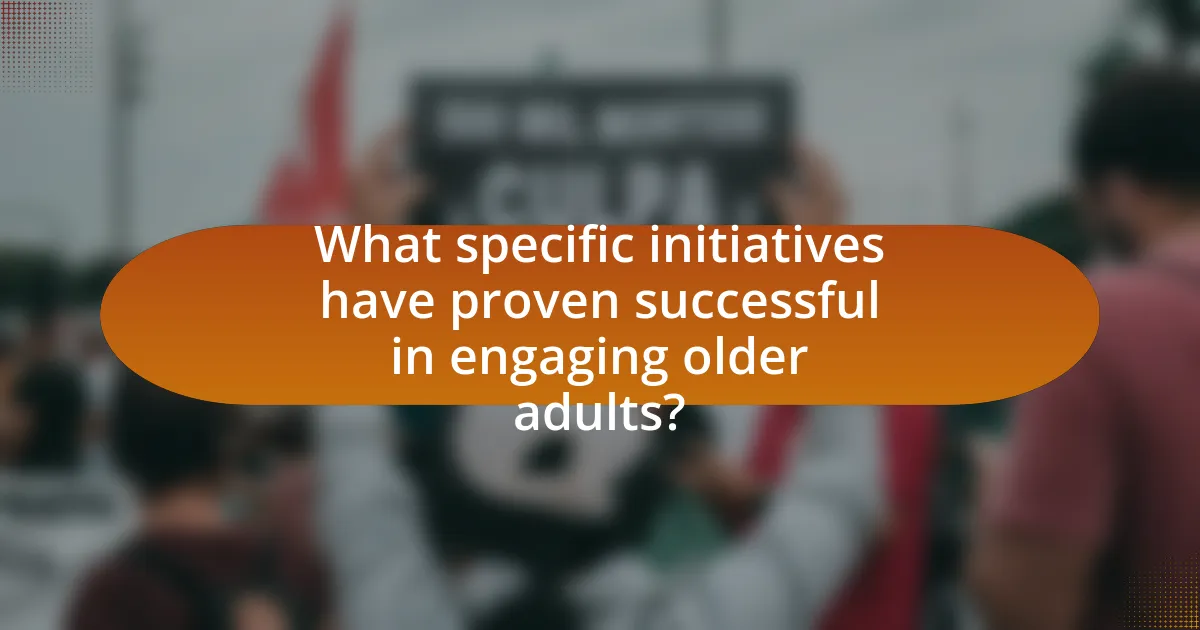
What specific initiatives have proven successful in engaging older adults?
Successful initiatives for engaging older adults include community-based programs, technology training, and intergenerational activities. Community-based programs, such as senior centers and local volunteer opportunities, have shown to increase social interaction and civic involvement among older adults. For instance, the Experience Corps program, which pairs older adults with children in schools, has demonstrated improved literacy outcomes for students and enhanced social engagement for seniors. Technology training initiatives, like AARP’s TEK Academy, empower older adults to use digital tools, fostering connections and participation in online communities. Intergenerational activities, such as shared gardening projects or mentorship programs, have also proven effective, as they create meaningful relationships between older adults and younger generations, enhancing community ties and reducing isolation. These initiatives are supported by research indicating that social engagement significantly improves mental and physical health outcomes for older adults.
What types of civic activities are most appealing to older adults?
Volunteering and community service are the most appealing civic activities for older adults. Research indicates that older adults often seek opportunities that allow them to contribute their skills and experience, such as mentoring youth, participating in local charities, or engaging in environmental conservation efforts. A study published in the Journal of Gerontology found that 60% of older adults reported higher life satisfaction when involved in volunteer activities, highlighting the positive impact of civic engagement on their well-being.
How do volunteer opportunities impact older adults’ engagement?
Volunteer opportunities significantly enhance older adults’ engagement by providing social interaction, a sense of purpose, and opportunities for skill utilization. Research indicates that older adults who participate in volunteer activities report higher levels of life satisfaction and lower rates of depression. For instance, a study published in the Journal of Gerontology found that older volunteers experienced improved mental health and social connectedness, which are critical factors for engagement. Additionally, volunteering allows older adults to contribute their skills and knowledge, fostering a sense of belonging and community involvement, which further boosts their overall engagement in civic activities.
What role do advocacy and activism play in older adults’ civic participation?
Advocacy and activism significantly enhance older adults’ civic participation by empowering them to influence policies and community issues that affect their lives. Engaging in advocacy allows older adults to voice their concerns, share their experiences, and mobilize for change, which fosters a sense of agency and belonging. Research indicates that older adults who participate in advocacy report higher levels of life satisfaction and social connectedness, demonstrating the positive impact of civic engagement on their well-being. For instance, a study published in the Journal of Gerontology found that older adults involved in advocacy efforts are more likely to engage in other forms of civic participation, such as voting and community service, thereby reinforcing their role in shaping societal outcomes.
How can intergenerational programs foster civic engagement?
Intergenerational programs can foster civic engagement by creating opportunities for collaboration between different age groups, which enhances community involvement and social responsibility. These programs often involve shared activities such as community service projects, where older adults and younger participants work together, thereby promoting mutual understanding and respect. Research indicates that such interactions can lead to increased civic participation; for example, a study by the Generations United organization found that intergenerational programs significantly improve the likelihood of participants engaging in community activities, with 70% of participants reporting a greater sense of belonging and responsibility towards their community. This collaborative environment not only empowers older adults but also instills civic values in younger generations, reinforcing the importance of active participation in civic life.
What are the benefits of involving younger generations in civic activities with older adults?
Involving younger generations in civic activities with older adults fosters intergenerational relationships, enhances community cohesion, and promotes mutual learning. These interactions allow younger individuals to gain insights from the experiences and wisdom of older adults, while older adults benefit from the energy and fresh perspectives of the youth. Research indicates that such engagement can lead to improved mental health and well-being for older adults, as social connections are linked to lower rates of depression and increased life satisfaction. Additionally, a study published in the Journal of Intergenerational Relationships found that intergenerational programs can enhance civic responsibility among youth, encouraging them to become more active and engaged citizens.
How can intergenerational initiatives be structured for maximum impact?
Intergenerational initiatives can be structured for maximum impact by fostering meaningful interactions between different age groups through collaborative projects that address community needs. These initiatives should include clear objectives that align with the interests and strengths of both younger and older participants, ensuring that each group contributes uniquely to the project. Research indicates that programs like the Experience Corps, which pairs older adults with children in literacy tutoring, demonstrate significant improvements in academic performance and social engagement for both age groups. Additionally, incorporating regular feedback mechanisms allows participants to share their experiences and adapt the initiative to better meet their needs, enhancing overall effectiveness.
What lessons can be learned from successful case studies?
Successful case studies in engaging older adults in civic participation reveal several key lessons. First, effective communication tailored to the preferences of older adults enhances participation rates. For instance, a study by the National Institute on Aging found that personalized outreach significantly increased engagement among seniors. Second, creating inclusive environments that foster social connections is crucial; programs that incorporate social activities alongside civic engagement have shown higher retention rates. Research from the Gerontological Society of America indicates that older adults are more likely to participate when they feel a sense of belonging. Lastly, providing accessible resources and training empowers older adults to take active roles in civic activities, as demonstrated by initiatives that offer workshops on community involvement, leading to a 40% increase in participation according to data from AARP.
What strategies were employed in notable civic engagement programs?
Notable civic engagement programs employed strategies such as community organizing, participatory budgeting, and intergenerational collaboration. Community organizing involves mobilizing individuals to address local issues, fostering a sense of ownership and empowerment among participants. Participatory budgeting allows community members to directly influence budget decisions, enhancing transparency and accountability in governance. Intergenerational collaboration brings together older adults and younger generations to share knowledge and skills, promoting mutual understanding and respect. These strategies have been shown to increase participation rates and improve community outcomes, as evidenced by programs like the Participatory Budgeting Project, which reported increased civic engagement and satisfaction among participants.
How can these lessons be applied to new initiatives?
The lessons learned from engaging older adults in civic participation can be applied to new initiatives by implementing tailored communication strategies and fostering inclusive environments. For instance, utilizing clear, accessible language in outreach materials ensures that older adults understand the opportunities available to them. Research indicates that initiatives that prioritize social connections and community involvement significantly enhance participation rates among older adults, as evidenced by a study published in the Journal of Gerontology, which found that community-based programs that emphasize peer engagement lead to a 30% increase in civic participation among seniors. Additionally, creating flexible participation options, such as virtual meetings or varied time slots, accommodates the diverse needs of older adults, thereby increasing their likelihood of involvement in new initiatives.
What practical tips can organizations implement to enhance engagement?
Organizations can enhance engagement by implementing targeted communication strategies, fostering inclusive environments, and providing opportunities for meaningful participation. Targeted communication strategies, such as using clear and accessible language, can help ensure that older adults understand the information being shared, which is crucial for their involvement. Creating inclusive environments involves actively welcoming older adults and addressing their specific needs, such as mobility or technology access, which can significantly increase their willingness to participate. Additionally, providing opportunities for meaningful participation, such as volunteering or leadership roles in community projects, empowers older adults and reinforces their sense of purpose, leading to higher engagement levels. Research indicates that when older adults feel valued and included, their participation rates in civic activities increase, demonstrating the effectiveness of these strategies.
